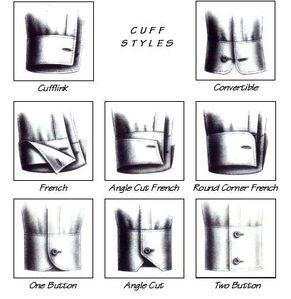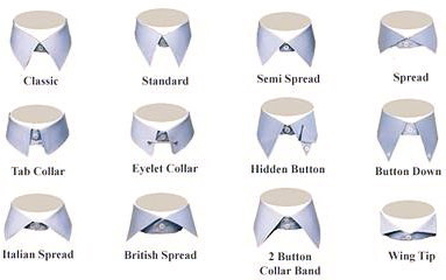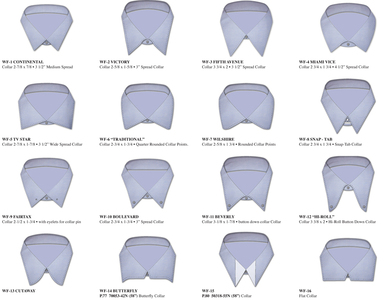Collars & Cuffs...

As with many things in life, the more you know about what works for you, the smoother things tend to go. Great example here would be shopping for new clothing. If you know what kind of collar works best with your face when it comes to dress shirts, it eliminates you from having to consider a bunch of things that you may not be interested in anyway. For example, a man with a narrower face would do well to avoid shirts with narrow, pointed collars as it could make your face look even narrower and vice versa with a rounder face and a spread collar. Of course, what you do for a living could also influence your collar of choice.
The Shirt Collar...
When choosing a shirt collar, I consider two main things; the height of the collar and the collar's tie-space. The height of the collar in front is important because it should be in proportion to the length of one's neck. Short necks can be given the appearance of length by wearing a collar that is cut low in the front and vice versa. Also, when considering the height of your shirt collar in the back you don't want to have more than half an inch of collar showing above your suit collar.
The collar tie-space refers to the space that is made with the two leaves of a shirt collar do not meet in the front. This is typically done so that there is enough room for the tie knot and is usually not an issue unless the collar is a close point collar which only allows for a very narrow tie knot. Finally, there is the choice between quarter-inch top-stitching or edge-stitched top-stitching. Edge-stitching gives a cleaner look to your shirt collar because it blends into it as opposed to the quarter-inch top-stitching which is more obvious and can be an issue if you use collar stays as you can't insert your stays all the way to the collar point as you can with edge-stitching. Most shirt makers tend to stay away from edge-stitching however because it's harder and ultimately more costly for them to mass produce. If you do get a shirt with edge-stitching and it's done lousily, you sometimes get bunching of loose fabric when you iron.
The collar tie-space refers to the space that is made with the two leaves of a shirt collar do not meet in the front. This is typically done so that there is enough room for the tie knot and is usually not an issue unless the collar is a close point collar which only allows for a very narrow tie knot. Finally, there is the choice between quarter-inch top-stitching or edge-stitched top-stitching. Edge-stitching gives a cleaner look to your shirt collar because it blends into it as opposed to the quarter-inch top-stitching which is more obvious and can be an issue if you use collar stays as you can't insert your stays all the way to the collar point as you can with edge-stitching. Most shirt makers tend to stay away from edge-stitching however because it's harder and ultimately more costly for them to mass produce. If you do get a shirt with edge-stitching and it's done lousily, you sometimes get bunching of loose fabric when you iron.
Cuffing Season...

"You can have whatever you like." - T.I
Cuff preference is one of the easiest decisions to make when it comes to custom shirting or even off the rack. There are so many options out that that it literally is matter of how you're feeling at the moment. Some men like french cuffs, whether its because of their work environment or the flash of the cufflink. You can get them angle cut, round corner, convertible. Others yet prefer the barrel cuff with one, two, maybe three buttons.
Ok, so maybe its not an easy decision afterall.
Cuff preference is one of the easiest decisions to make when it comes to custom shirting or even off the rack. There are so many options out that that it literally is matter of how you're feeling at the moment. Some men like french cuffs, whether its because of their work environment or the flash of the cufflink. You can get them angle cut, round corner, convertible. Others yet prefer the barrel cuff with one, two, maybe three buttons.
Ok, so maybe its not an easy decision afterall.



